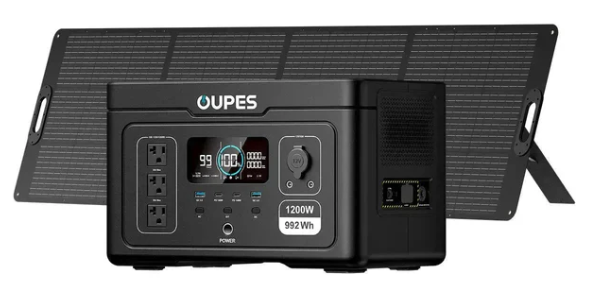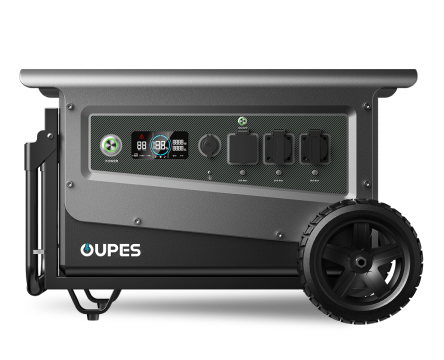
Overview
Off-grid solar systems—whether for homes, cabins, RVs, or portable solar generators—must handle both energy shortages and energy surpluses. While most discussions focus on how to get enough power, a frequently overlooked topic is what happens when solar panels generate more energy than you can use or store.
Unlike grid-tied systems, off-grid setups cannot sell excess electricity back to the utility. Instead, specialized electronics such as charge controllers and inverters must manage surplus energy safely. This article breaks down what actually occurs when your batteries are full, how excess power is handled, and how portable power stations from brands like OUPES fit into the picture.
How Off-Grid Solar Systems Work
Core Components of an Off-Grid System
Typical off-grid solar systems include:
- Solar panels
- Charge controllers (PWM or MPPT)
- Battery banks (often LiFePO4)
- Inverters (pure sine wave)
- Backup generators (optional)
- Distribution/load circuits
How Energy Flows
During daylight, solar panels produce DC electricity. This energy flows to the charge controller, which regulates current and voltage to safely charge batteries. The inverter converts DC to AC for household appliances.
The system is designed to prioritize battery charging first. Once the battery is full, the system must decide what to do with any additional energy.
What Happens to Excess Solar Power?
1. The Charge Controller Limits Solar Input
When batteries reach 100% state of charge, modern MPPT charge controllers enter a mode called voltage regulation or float stage. They effectively reduce the current coming from the solar panels so that no more energy flows into the battery.
This means unused solar power is simply not harvested.
2. Solar Panels Remain Energized but Unloaded
Panels still produce electricity, but because the charge controller limits current, the panels operate at a point where they generate only a fraction of their potential output—preventing overcharging or reverse current.
3. No Power Is Exported (Unlike Grid-Tied Systems)
Off-grid systems cannot send electricity back to the utility grid. Excess energy remains unused unless the system includes dump loads or additional appliances.
Battery Storage & Charge Controller Management
Stages of Charging
Solar batteries (especially LiFePO4) follow a staged charging profile:
- Bulk: Maximum current until voltage target is reached
- Absorption: Voltage maintained; current tapers down
- Float: Voltage lowered to a maintenance level
Once in float, the system only supplies enough energy to counteract natural battery self-discharge, which is very low for LiFePO4 chemistry.
Why Batteries Must Not Overcharge
Overcharging any chemistry—lead-acid or lithium—can cause damage. LiFePO4 batteries have built-in BMS systems that shut off charging when cell voltages exceed safe levels. Charge controllers provide the first layer of protection; BMS circuits provide the second.
What Happens When the Battery Is Full?
Once the BMS or charge controller stops accepting power:
- Panels continue producing voltage
- The controller reduces current to nearly zero
- No meaningful power flows into the system
- Excess solar energy is wasted but harmless
Using Excess Power for Additional Loads
1. Running Appliances During Peak Sun Hours
One of the best strategies in off-grid living is to schedule energy-intensive tasks during the day when solar output is strongest, such as:
- Water heating
- Laundry
- Air conditioning
- Pumping water
- Power tools
2. Adding Dump Loads
Some off-grid systems include resistive dump loads that consume surplus power to prevent overvoltage. Common dump loads include:
- Water heating elements
- Space heaters
- Hydronic systems
3. Charging Additional Battery Banks or Portable Power Stations
Users often take advantage of excess solar by charging separate devices such as:
- Portable power stations
- RV batteries
- Power tool batteries
- Electric bike batteries
Portable solar generators from brands like OUPES are commonly used to store surplus energy as a secondary reserve.
Off-Grid vs. Grid-Tied: What’s Different?
| Feature | Off-Grid System | Grid-Tied System |
|---|---|---|
| How excess energy is handled | Not used unless loads are added | Sent back to the grid (net metering where allowed) |
| Battery requirement | Mandatory | Optional |
| Solar availability at night | Must rely on batteries | Grid provides backup power |
| Energy independence | Complete independence | Partial; grid still required |
What Excess Power Means for Portable Solar Generators
1. Portable Power Stations Charge Until Full
Portable power stations, including models offered by OUPES, contain built-in MPPT controllers. When the battery reaches full capacity, the station stops accepting incoming solar power.
2. Solar Panels Idle After Charging
Once the device is charged:
- Panels still produce voltage
- The internal controller shuts down charging
- No excess electricity flows into the device
3. You Can Use Surplus Power for Additional Electronics
While the power station is full, solar energy can be redirected through parallel connections to:
- 12V appliances
- Charge controllers powering RV batteries
- DC loads connected to a separate system
4. Protection Against Overvoltage
Portable solar generators include advanced BMS protection, preventing:
- Overcharging
- Overvoltage
- Backflow
- Overcurrent
How to Properly Plan an Off-Grid Solar System
1. Size Your Battery Bank Correctly
Most off-grid households require enough battery storage for 24–72 hours of autonomy. Undersized batteries cause wasted solar energy during sunny days.
2. Oversize Solar Panels for Winter Production
According to NREL, winter solar production can drop 40–80% depending on latitude. A larger array ensures consistent charging year-round.
3. Understand Daily Load Profiles
Knowing your average kWh consumption helps determine whether excess power will be frequent. Daytime-heavy loads help balance solar generation.
4. Consider Adding Secondary Storage
For cabins, RVs, or homesteads, portable power stations make excellent supplementary storage for surplus solar energy.
FAQ
1. Is excess solar power wasted in an off-grid system?
Yes. If your batteries are full and no additional loads are connected, excess power is not harvested.
2. Can off-grid systems sell surplus electricity?
No. Only grid-tied systems with net metering can export energy to the grid.
3. Will excess power damage my solar panels?
No. Panels are designed to operate safely without load.
4. Can I store surplus power in a portable solar generator?
Yes. Many off-grid homeowners use portable power stations as secondary storage solutions.
5. What is the best way to use excess solar power?
Daytime-heavy tasks such as heating water, laundry, or running pumps are recommended.
6. Will my charge controller shut off if there is too much solar?
Yes. MPPT controllers regulate current to prevent battery overcharging.




























